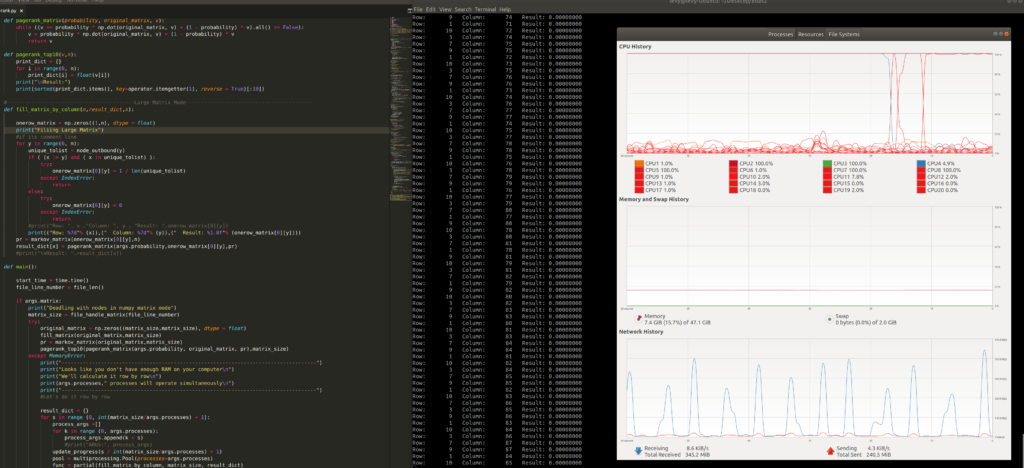
Following codes are used for Big Data Assignment 2:
Given the Google web graph: http://snap.stanford.edu/data/web-Google.html
File Format:
# Comment
# Comment
...
FromNodeID(Tab)ToNodeID
FromNodeID(Tab)ToNodeID
FromNodeID(Tab)ToNodeID
...Three modes are written in this script:
- Graph Mode: Use NetworkX and Graph to connect all nodes and edges. (Fastest and recommended, also default mode)
- Matrix Mode: Textbook method, convert all nodes and edges to the Stochastic matrix, iterate until we find the convergence of the Markov chain. (Sample input: matrix.txt)
- Large Matrix Mode: Multi-process will operate (according to -t) to read several rows at the same time and calculate the convergence of the Markov chain. This is Due to RAM size limit, for a sample input file with 1 million nodes, a matrix (or array in Numpy) size 1M1M is needed, the memory space required is 1M1M*float32, which requires more than 8TB and can be calculated with following code:
import numpy as np
n = np.zeros((1000000,1), dtype=float)
print("%d bytes" % (n.size * n.itemsize))
In the early stage I tried to use an hdf5 file system with Pytables to store the whole matrix then slice each row to operate, but since it’s read and write are too I/O bounded, I have no other option but to store data in RAM.

Arguments:
- -f –file | Target file.
- -m –matrix | Use tradition matrix mode instead of Graph mode, requires more memory
- -p –probability | Probability for jumping to other random webpages. Solves dead-ends and spider traps
- -t –processes | Multi-processes for large matrix
Library you may need
- operator (Pass different arguments to different process)
- argparse (pass all arguments)
- networkx (graph)
- numpy (All matrix and array op)
- shutil (move the whole file to RAM, increase read speed)
sudo pip3 install networkx argparse numpyRun:
python3 pagerank.py -f web-Google.txtpagerank.py
import argparse
import time
import sys
import os
import networkx as nx
import numpy as np
import operator
import shutil
import multiprocessing
from multiprocessing import Pool
from functools import partial
from networkx.utils import not_implemented_for
parser = argparse.ArgumentParser(description="pagerank")
parser.add_argument('-f', '--file', default="web-Google.txt",
help="File location. If empty, Use web-Google.txt download from http://snap.stanford.edu/data/web-Google.html")
parser.add_argument('-m', '--matrix', dest="matrix",
action="store_true", help="Use tradition matrix mode instead of Graph mode,requires more memory")
parser.add_argument('-p', '--probability', default = 0.85,
help="Probability for jumping to other random webpage. Solves dead-ends and spider traps")
parser.add_argument('-t', '--processes', default = 20,
help="Multi-processes for large matrix")
args = parser.parse_args()
def file_len():
with open(args.file) as f:
for i, l in enumerate(f):
pass
return i + 1
#----------Progress Bar----------
# From: https://stackoverflow.com/questions/3160699/python-progress-bar/55003596
def update_progress(progress):
barLength = 20 # Modify this to change the length of the progress bar
status = ""
if isinstance(progress, int):
progress = float(progress)
if not isinstance(progress, float):
progress = 0
status = "error: progress var must be float\r\n"
if progress < 0:
progress = 0
status = "Halt...\r\n"
if progress >= 1:
progress = 1
status = "Done...\r\n"
block = int(round(barLength*progress))
text = "\rPercent: [{0}] {1}% {2}".format( "#"*block + "-"*(barLength-block), progress*100, status)
sys.stdout.write(text)
sys.stdout.flush()
#----------Graph Mode----------
# Put all nodes and edges into graph
def file_handle_graph(G,file_len):
i = 0
node_file = open(args.file, "r")
print("Reading File into graph...\n")
#if its comment line
for line in node_file:
line = line.rstrip()
if line[0] == "#":
continue
line_arr = line.split("\t")
add_node_to_graph(G, int(line_arr[0]))
add_node_to_graph(G, int(line_arr[1]))
add_edge_to_graph(G,int(line_arr[0]),int(line_arr[1]))
update_progress(i/file_len)
i += 1
node_file.close()
print("\nReading complete\n")
def creat_network_graph():
G = nx.DiGraph()
return G
def add_node_to_graph(G, nodeid):
if G.has_node(nodeid):
pass
else:
G.add_node(nodeid)
def add_edge_to_graph(G, fromid, toid):
if G.has_edge(fromid,toid):
pass
else:
G.add_edge(fromid, toid)
def pagerank(G, alpha=0.85, personalization=None,
max_iter=2000, tol=1.0e-9, nstart=None, weight='weight',
dangling=None):
if len(G) == 0:
return {}
print("Creating a copy in stochastic form")
W = nx.stochastic_graph(G, weight=weight)
N = W.number_of_nodes()
print("Choosing fixed starting vector")
if nstart is None:
x = dict.fromkeys(W, 1.0 / N)
else:
# Normalized nstart vector
s = float(sum(nstart.values()))
x = dict((k, v / s) for k, v in nstart.items())
print("Assigning personalization vector")
if personalization is None:
# Assign uniform personalization vector if not given
p = dict.fromkeys(W, 1.0 / N)
else:
s = float(sum(personalization.values()))
p = dict((k, v / s) for k, v in personalization.items())
if dangling is None:
# Use personalization vector if dangling vector not specified
dangling_weights = p
else:
s = float(sum(dangling.values()))
dangling_weights = dict((k, v / s) for k, v in dangling.items())
dangling_nodes = [n for n in W if W.out_degree(n, weight=weight) == 0.0]
i = 0
print("power iterating")
# power iteration: make up to max_iter iterations
for _ in range(max_iter):
update_progress( i/max_iter *120)
xlast = x
x = dict.fromkeys(xlast.keys(), 0)
danglesum = alpha * sum(xlast[n] for n in dangling_nodes)
for n in x:
# this matrix multiply looks odd because it is
# doing a left multiply x^T=xlast^T*W
for nbr in W[n]:
x[nbr] += alpha * xlast[n] * W[n][nbr][weight]
x[n] += danglesum * dangling_weights.get(n, 0) + (1.0 - alpha) * p.get(n, 0)
# check convergence, l1 norm
err = sum([abs(x[n] - xlast[n]) for n in x])
if err < N * tol:
return x
i+=1
raise nx.PowerIterationFailedConvergence(max_iter)
#----------Matrix Mode----------
# File handling
def file_handle_matrix(file_len):
i = 0
max_node_id = 0
shutil.copyfile(args.file, '/dev/shm/temp.txt')
node_file = open("/dev/shm/temp.txt", "r")
print("Reading File...\n")
#if its comment line
for line in node_file:
line = line.rstrip()
if line[0] == "#":
continue
line_arr = line.split("\t")
if ( int(line_arr[0])> max_node_id ):
max_node_id = int(line_arr[0])
if ( int(line_arr[1])> max_node_id ):
max_node_id = int(line_arr[1])
update_progress(i/file_len)
i += 1
node_file.close()
print("\nReading complete\n")
os.remove("/dev/shm/temp.txt")
return max_node_id + 1
#how many unique outbound in toatl from a single node?
def node_outbound(nodeid):
shutil.copyfile(args.file, '/dev/shm/temp.txt')
node_file = open("/dev/shm/temp.txt", "r")
#print("Counting outbound for node",nodeid)
unique_tolist = []
for line in node_file:
line = line.rstrip()
if line[0] == "#":
continue
line_arr = line.split("\t")
if ( int(line_arr[0]) == nodeid ):
if int(line_arr[1]) in unique_tolist:
pass
else:
unique_tolist.append( int(line_arr[1]) )
#print("Total outbound: ", len(unique_tolist))
#print("Outbound: ",unique_tolist)
os.remove("/dev/shm/temp.txt")
return unique_tolist
# random browser factor 0.2
def fill_matrix(original_matrix,n):
node_file = open(args.file, "r")
print("Filiing Matrix\n")
#if its comment line
for y in range(0, n):
unique_tolist = node_outbound(y)
for x in range(0, n):
#print("X: ",x)
#print("Y: ",y)
if ( (x != y) and ( x in unique_tolist) ):
original_matrix[x][y] = 1 / len(unique_tolist)
else:
original_matrix[x][y] = 0
node_file.close()
print("\nOriginal Matrix: \n", original_matrix)
def markov_matrix(original_matrix,n):
pr = np.zeros((n, 1), dtype=float)
for i in range(n):
pr[i] = float(1) / n
return (pr)
def pagerank_matrix(probability, original_matrix, v):
while ((v == probability * np.dot(original_matrix, v) + (1 - probability) * v).all() == False):
v = probability * np.dot(original_matrix, v) + (1 - probability) * v
return v
def pagerank_top10(v,n):
print_dict = {}
for i in range(0, n):
print_dict[i] = float(v[i])
print("\nResult:")
print(sorted(print_dict.items(), key=operator.itemgetter(1), reverse = True)[:10])
#----------Large Matrix Mode----------
def fill_matrix_by_column(n,result_dict,x):
onerow_matrix = np.zeros((1,n), dtype = float)
print("Filiing Large Matrix")
#if its comment line
for y in range(0, n):
unique_tolist = node_outbound(y)
if ( (x != y) and ( x in unique_tolist) ):
try:
onerow_matrix[0][y] = 1 / len(unique_tolist)
except IndexError:
return
else:
try:
onerow_matrix[0][y] = 0
except IndexError:
return
#print("Row: ", x ,"Column: ", y , "Result: ",onerow_matrix[0][y])
print(("Row: %7d"% (x)),(" Column: %7d"% (y)),(" Result: %1.8f"% (onerow_matrix[0][y])))
pr = markov_matrix(onerow_matrix[0][y],n)
result_dict[x] = pagerank_matrix(args.probability,onerow_matrix[0][y],pr)
#print("\nResult: ",result_dict[x])
def main():
start_time = time.time()
file_line_number = file_len()
if args.matrix:
print("Deadling with nodes in numpy matrix mode")
matrix_size = file_handle_matrix(file_line_number)
try:
original_matrix = np.zeros((matrix_size,matrix_size), dtype = float)
fill_matrix(original_matrix,matrix_size)
pr = markov_matrix(original_matrix,matrix_size)
pagerank_top10(pagerank_matrix(args.probability, original_matrix, pr),matrix_size)
except MemoryError:
print("------------------------------------------------------------------------------------")
print("Looks like you don't have enough RAM on your computer\n")
print("We'll calculate it row by row\n")
print(args.processes," processes will operate simultaneously\n")
print("------------------------------------------------------------------------------------")
#Let's do it row by row
result_dict = {}
for s in range (0, int(matrix_size/args.processes) + 1):
process_args =[]
for k in range (0, args.processes):
process_args.append(k + s)
#print("ARGS:", process_args)
update_progress(s / int(matrix_size/args.processes) + 1)
pool = multiprocessing.Pool(processes=args.processes)
func = partial(fill_matrix_by_column, matrix_size, result_dict)
pool.map(func, process_args)
pool.close()
pool.join()
s += args.processes
pagerank_top10(result_dict,matrix_size)
else:
G = creat_network_graph()
file_handle_graph(G,file_line_number)
print ("Ranking...")
pr = pagerank(G, alpha=args.probability,max_iter=2000)
#print (pr)
#print(type(pr))
print("\nResult:")
print(sorted(pr.items(), key=operator.itemgetter(1), reverse = True)[:10])
print("--- Total run time: %s seconds ---" % (time.time() - start_time))
if __name__ == "__main__":
main()
'''
References:
How to use the NumPy zeros function
https://stackoverflow.com/questions/845058/how-to-get-line-count-cheaply-in-python
https://stackoverflow.com/questions/3160699/python-progress-bar
http://ilpubs.stanford.edu:8090/422/1/1999-66.pdf
https://networkx.github.io/documentation/networkx-1.10/reference/generated/networkx.algorithms.link_analysis.pagerank_alg.pagerank.html
https://stackoverflow.com/questions/1053928/very-large-matrices-using-python-and-numpy
https://www.pytables.org/_modules/tables/filters.html
https://networkx.github.io/documentation/networkx-1.10/reference/classes.digraph.html
https://plot.ly/python/network-graphs/
https://blog.csdn.net/bigbennyguo/article/details/88345542
https://www.howtoforge.com/storing-files-directories-in-memory-with-tmpfs
https://www.pytables.org/usersguide/libref/file_class.html
https://stackoverflow.com/questions/25553919/passing-multiple-parameters-to-pool-map-function-in-python/25553970
https://www.python-course.eu/python3_formatted_output.php
Python Exception Handling: IndexError
https://developers.google.com/edu/python/lists
https://stackoverflow.com/questions/25553919/passing-multiple-parameters-to-pool-map-function-in-python/25553970
https://segmentfault.com/a/1190000000711128
'''
Top 10 Results:
[(597621, 0.0009241304287175943), (41909, 0.0009214639855385305), (163075, 0.0009049071491006198), (537039, 0.0008992631802222364), (384666, 0.0007872247076457703), (504140, 0.0007655435306714571), (486980, 0.0007262612106941519), (605856, 0.0007190037632145288), (32163, 0.0007129961306074605), (558791, 0.0007103219427793649)]
--- Total run time: 426.2423915863037 seconds ---Further improvements can be done if you have CUDA support device and high bandwidth RAM:
https://devblogs.nvidia.com/numba-python-cuda-acceleration/
[wpedon id=”461″ align=”center”]